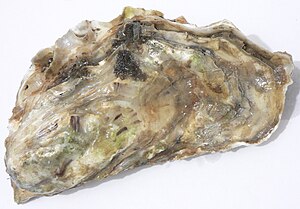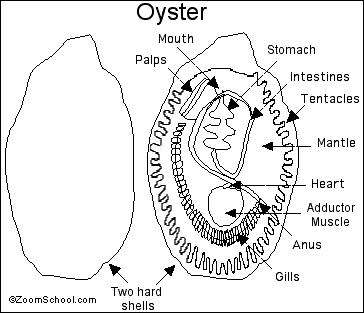Source google.com.pk
Oyster
There are many food items in the world that evoke the question, “How hungry did the first person to eat that have to be?” But few such dishes can rival the raw oyster for unpalatable appearance and general “ick” factor.
If undaunted by the oyster’s rough, rock-hard, nearly-impossible-to-open shell, the undoubtedly famished first taster would then have confronted the gray, slimy, almost phlegmatic appearance of its plump body. Once beyond any primal gag reflex though, this seminal slurper would have been surprisingly rewarded with the oyster’s delicate, toothy texture, rich flavor, and salty liquor. Oysters are also high in calcium, iron, and protein. Admittedly, they’re not for everyone, but adventurous humans the world over have enjoyed oysters, raw and cooked, for thousands of years.
Although it is possible for food oysters to produce pearls, they should not be confused with actual pearl oysters, which are from a different family of bivalves. True oysters, which belong to the Ostreidae family, are found throughout the world’s oceans, usually in shallow waters and in colonies called beds or reefs. Among the most popular and heavily harvested species are the Eastern American oyster (Crassostrea virginica), found in Atlantic waters from Canada to Argentina, and the Pacific oyster (Crassostrea gigas), found from Japan to Washington state and as far south as Australia.
Oyster shells are usually oval or pear-shaped, but will vary widely in form depending on what they attach to. They are generally whitish-gray in outer shell color, and their inside shell is usually a porcelain white. They have extremely strong adductor muscles to close their shells when threatened.
Oysters feed by extracting algae and other food particles from the water they are almost constantly drawing over their gills. They reproduce when the water warms by broadcast spawning, and will change gender once or more during their lifetime.
Commercial harvesting of oysters is regulated throughout most of their range, and they are not currently listed as threatened or endangered. However, they are extremely sensitive to water quality and susceptible to coastal pollution, and populations in many areas where they were once abundant have dwindled or disappeared. They can also retain toxins in their flesh, making them unhealthy for human consumption.




Oyster
There are many food items in the world that evoke the question, “How hungry did the first person to eat that have to be?” But few such dishes can rival the raw oyster for unpalatable appearance and general “ick” factor.
If undaunted by the oyster’s rough, rock-hard, nearly-impossible-to-open shell, the undoubtedly famished first taster would then have confronted the gray, slimy, almost phlegmatic appearance of its plump body. Once beyond any primal gag reflex though, this seminal slurper would have been surprisingly rewarded with the oyster’s delicate, toothy texture, rich flavor, and salty liquor. Oysters are also high in calcium, iron, and protein. Admittedly, they’re not for everyone, but adventurous humans the world over have enjoyed oysters, raw and cooked, for thousands of years.
Although it is possible for food oysters to produce pearls, they should not be confused with actual pearl oysters, which are from a different family of bivalves. True oysters, which belong to the Ostreidae family, are found throughout the world’s oceans, usually in shallow waters and in colonies called beds or reefs. Among the most popular and heavily harvested species are the Eastern American oyster (Crassostrea virginica), found in Atlantic waters from Canada to Argentina, and the Pacific oyster (Crassostrea gigas), found from Japan to Washington state and as far south as Australia.
Oyster shells are usually oval or pear-shaped, but will vary widely in form depending on what they attach to. They are generally whitish-gray in outer shell color, and their inside shell is usually a porcelain white. They have extremely strong adductor muscles to close their shells when threatened.
Oysters feed by extracting algae and other food particles from the water they are almost constantly drawing over their gills. They reproduce when the water warms by broadcast spawning, and will change gender once or more during their lifetime.
Commercial harvesting of oysters is regulated throughout most of their range, and they are not currently listed as threatened or endangered. However, they are extremely sensitive to water quality and susceptible to coastal pollution, and populations in many areas where they were once abundant have dwindled or disappeared. They can also retain toxins in their flesh, making them unhealthy for human consumption.
Oyster

Oyster
Oyster
Oyster

Oyster

Oyster


No comments:
Post a Comment